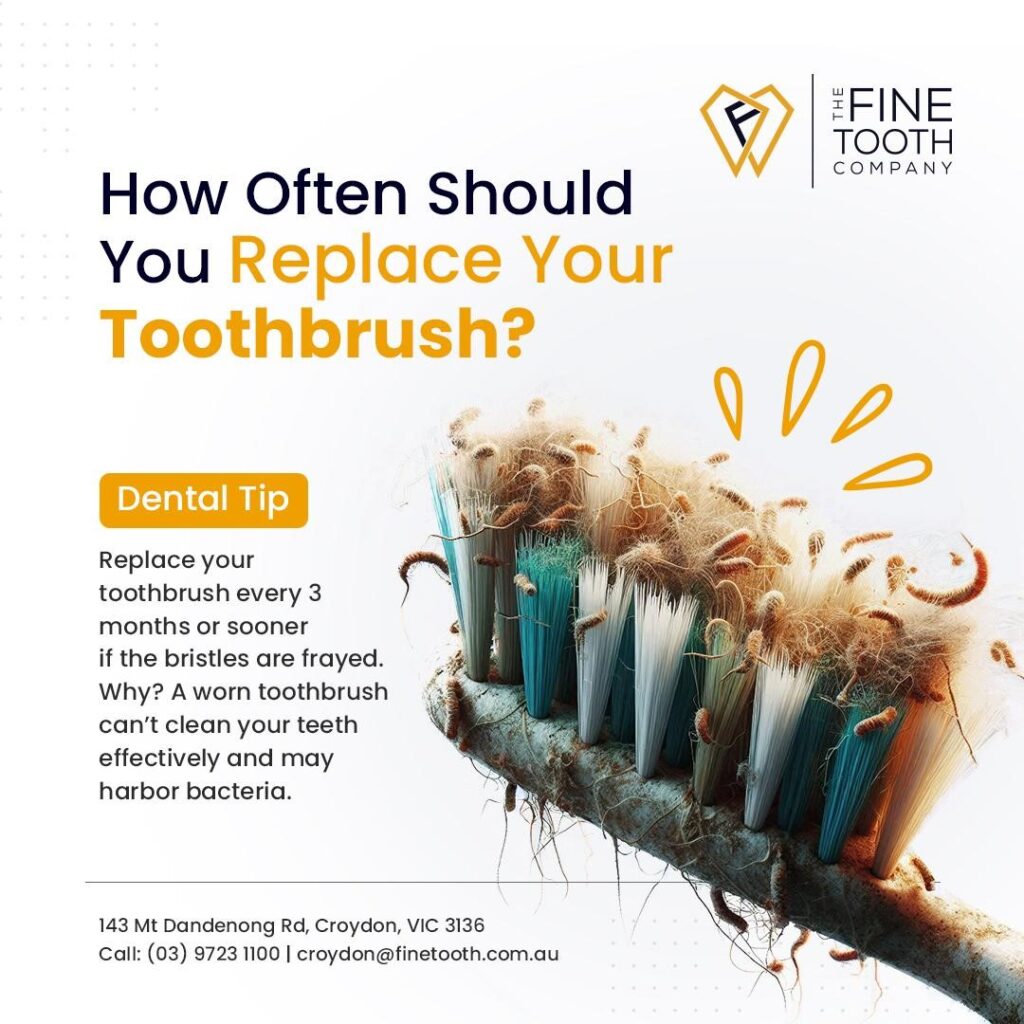
Your toothbrush is one of your most important tools for maintaining good oral health. But just like any other tool, it doesn’t last forever. Over time, the bristles wear down, reducing their effectiveness at cleaning your teeth. So, how often should you be replacing it?
At The Fine Tooth Company in Croydon, Croydon dentist often get asked this very question, and while the answer might seem straightforward, there’s a little more to it than you might think.
Let’s dive into when and why you should replace your toothbrush to keep your smile healthy.
General Rule: Every 3 to 4 Months
The American Dental Association (ADA) recommends that you replace your toothbrush every 3 to 4 months. This is the most widely accepted guideline, and it applies to both manual and electric toothbrushes.
Why this timeframe? After 3 to 4 months of regular brushing, the bristles start to wear down, fray, and lose their cleaning effectiveness. Even if your toothbrush looks okay to you, the bristles might not be cleaning your teeth as effectively as they should.
Croydon Dental Tip:
Set a reminder on your phone or mark your calendar every three months to swap out your toothbrush. It’s an easy way to stay on top of your oral health routine.
When Should You Replace Your Toothbrush Sooner?
While 3 to 4 months is the typical guideline, there are situations where you should replace your toothbrush sooner:
1. Bristles Are Frayed
If the bristles of your toothbrush have frayed or bent, it’s time for a replacement. Frayed bristles aren’t effective at cleaning your teeth and can even cause damage to your gums by being too abrasive.
2. After Being Sick
If you’ve recently had a cold, the flu, or any other illness, it’s a good idea to replace your toothbrush. Germs and bacteria can linger on your toothbrush, and you don’t want to risk re-infecting yourself.
3. Before or After Dental Work
If you’ve had dental procedures like a deep cleaning, root canal, or other treatments, replacing your toothbrush afterward is crucial to ensure you’re not introducing bacteria or germs into your mouth during recovery.
4. Signs of Wear
If your toothbrush shows signs of wear and tear before the three-month mark, it’s better to replace it. This might include bent, missing, or uneven bristles.
What Happens If You Don’t Replace Your Toothbrush?
Failing to replace your toothbrush on time can lead to several oral health issues:
- Reduced cleaning effectiveness: As the bristles wear down, they lose their ability to properly remove plaque, which could contribute to gum disease, cavities, and bad breath.
- Bacterial build-up: An old toothbrush can harbor bacteria, which can lead to infections or irritations in your mouth, particularly if you’ve recently been ill.
- Gum damage: Worn-out bristles can become harsh on your gums, leading to irritation, bleeding, and even gum recession.
What to Look for in a New Toothbrush
When it’s time to replace your toothbrush, consider the following features to ensure you’re getting the best cleaning for your teeth:
- Soft bristles are best for most people, as they are gentle on your gums but still effective at cleaning plaque and food particles.
- A comfortable grip helps you hold the toothbrush properly, especially if you have arthritis or dexterity issues.
- A head size that fits comfortably in your mouth and allows easy access to all areas of your teeth.
Electric Toothbrushes: Do They Need Replacing Too?
Yes, electric toothbrushes need to be replaced, too. The brush heads on electric toothbrushes should be changed every 3 months, just like manual ones. However, electric toothbrushes tend to have more durable bristles, so some wear might not be as noticeable.
The key is to pay attention to the performance of your toothbrush. If your electric toothbrush starts losing power, or the bristles appear worn down, it’s time for a replacement.
Croydon Tip for Electric Brushes:
Check if the bristles have a color indicator—many electric brush heads come with bristles that change color to indicate when it’s time for a new one.
Is There an Alternative to Regular Toothbrush Replacements?
While regular replacements are essential, there are a few habits that can help you maintain your toothbrush in the meantime:
- Rinse it thoroughly after every use to remove toothpaste and debris.
- Store it properly by keeping it upright and allowing it to dry fully between uses to avoid bacterial growth.
- Sanitize it occasionally by soaking it in mouthwash or using an antibacterial rinse.
Conclusion:
Replacing your toothbrush is a simple yet crucial step in maintaining good oral hygiene. It ensures that your teeth are getting the cleaning they need, and it helps avoid unnecessary risks to your oral and overall health.
At The Fine Tooth Company, we’re here to help guide you on all aspects of your oral care. If you have any questions about your toothbrush or general dental hygiene, feel free to reach out to the dentist near you! Ready to take the next step in your oral care routine? Book your next check-up today with us at The Fine Tooth Company Croydon!


